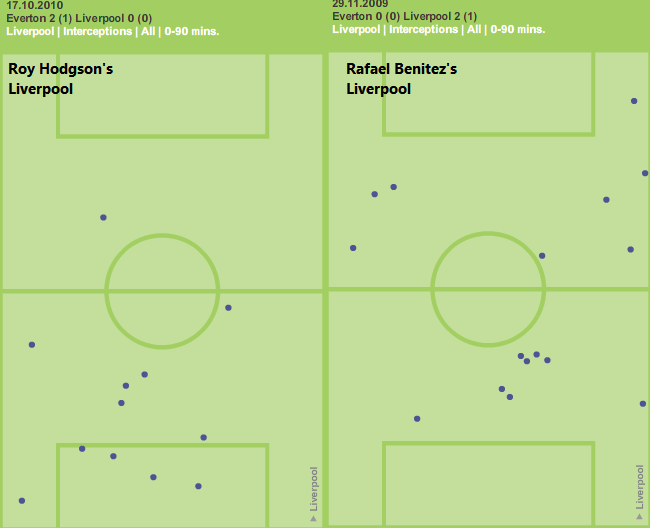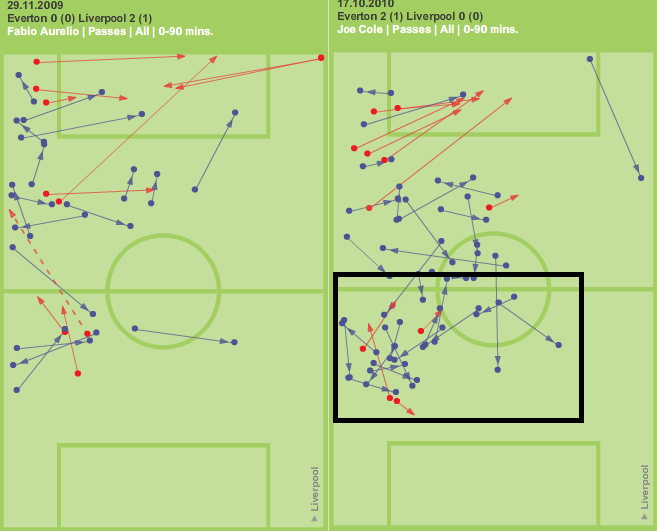The main criticism of Hodgson has been his complete turnaround in the way Liverpool play without the ball. Hodgson’s Liverpool aim to sit deep and keep their shape – this is no surprise, it is well documented that Hodgson’s training methods are primarily based on team shape and defensive structure
Such methods are a stark contrast compared to Liverpool’s pressing game under Rafael Benitez, who if there was a ‘Arrigo Sacchi Fan Club’, he would undoubtedly be the first one to join, giving him to a free Saachi face-mask as well as a year’s membership. Not only did fans like Benitez’s proactive methods, the team reacted well to the constriction of space and forcing the opposition into mistakes. This made Liverpool notably hard to play against; Wesley Sneijder, after Real Madrid’s 4-0 loss at Anfield in 2009, stated how difficult it was to see Madrid players amongst the wall of red shirts that surrounded him every time he picked up the ball.
Such philosophy has now been dismantled and Liverpool’s new defensive mantra is around keeping a deeper line, which has a knock-on effect in all areas of the pitch.
By playing a deeper line, it results in there being larger spaces in between the midfield and defence if the game is stretched. Such large gaps allow opposition to pass around and keep possession in dangerous areas of the pitch without much disturbance.
Firstly, as mentioned already, it allows opposition plenty of time to and space to find a teammate because of the space available to them. Secondly, when Liverpool win the ball-back, they’re starting from a deeper position without an obvious out-ball – this is because the midfielders are now so deep that passing the ball to them will place them in a precarious position where they will immediately be put under pressure. With midfielders now deeper to help protect the back-four, it leads to a huge a gap between them and the forward line meaning the direct ball to the centre forward will be fruitless. However, such route one ideas are the only sure-fire way of relieving the pressure and Liverpool often went long, an act that fans do not revere to.
By dropping so deep, it leads to an unbreakable cycle of inviting pressure, smashing it long, losing the ball, allow the opposition to keep possession and then when they win it back deep, the cycle starts all over again
Previous season (derby match @ Everton as example): On the ball they moved with purpose and obviously had a game-plan. Their movement was quick and penetrative, helping to provide a base for Liverpool to keep possession and control the match, something that cannot be said for many of Liverpool’s games under Roy Hodgson.
There are marked differences in the use of wide players in this 2-0 Liverpool win. Both Kuyt and Aurelio stay predominantly wide and high up the pitch. This stopped Everton’s full-backs getting forward and joining the midfield or looking for the overlap further up the pitch. This allows Liverpool’s full-backs, Johnson and Insua space to run into and join the midfield and time their runs into the final third.

This Liverpool pressing had a knock-on effect, it allowed the front four to stay forward and expect a pass from midfield or defence. A marked problem was Joe Cole’s defensive duties and lack of opportunities to play higher up the pitch. His passing chalkboard shows how he spent vast majorities of his time helping the defence and trying to get Liverpool out of tight spots. This resulted in Torres having no support and nobody to link up with. In the previous year, Fabio Aurelio stayed wide and looked to link up with his fellow attacking trio.

It is a worry that Roy Hodgson believes his methods from Fulham can be replicated with the same “success†at a bigger club, he has shown a distinct lack of flexibility and understanding of how to manage the Liverpool squad and adapt his methods to players at his disposal. Liverpool were hindered by Roy Hodgson’s overly defensive and negative system that has continually negated the attacking talents of this Liverpool side.

